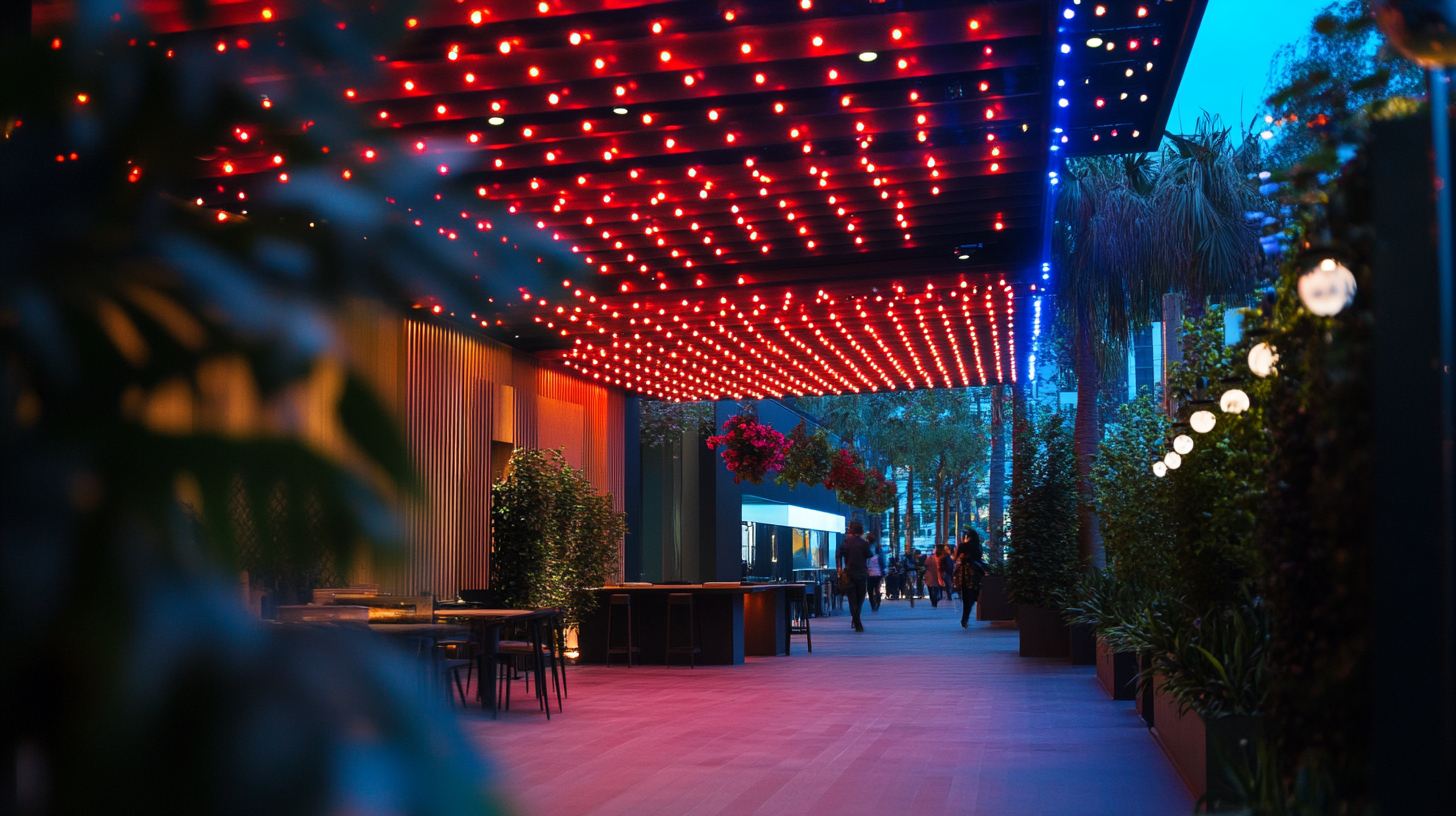
In an ever-evolving world where technology and design converge, the demand for innovative lighting solutions has never been more pronounced. Today’s global buyers are actively seeking out ways to enhance their spaces with not only aesthetics but also functionality and efficiency. This blog serves as the ultimate resource to navigate the dynamic landscape of lighting solutions, providing insights into the latest trends, products, and technologies that are shaping the way we illuminate our environments.
With a focus on sustainability and smart design, innovative lighting solutions are more than just fixtures; they represent a shift towards a more conscious and technologically integrated approach to lighting. From energy-efficient LEDs to smart home systems that adapt to our lifestyles, the options are endless. As we delve into this guide, global buyers will discover how to make informed decisions that reflect their values and elevate their spaces, ultimately embracing the transformative power of light in our daily lives.

The adoption of innovative lighting solutions presents numerous advantages for global buyers, particularly in an era increasingly focused on sustainability and efficiency. According to the Global EV Outlook 2021, electric vehicle deployment saw significant growth, indicating a burgeoning market for energy-efficient technologies—lighting included. As electric vehicles become more mainstream, the demand for complementary renewable energy solutions, such as solar-powered lighting, is also anticipated to rise.
A recent initiative by Lightsource bp exemplifies this trend. They have signed a groundbreaking collective virtual power purchase agreement (CVPPA) with The Fashion Pact, showcasing how industries can collaborate to amplify their sustainable practices. This partnership not only aims to reduce carbon footprints but also highlights the potential cost savings and energy independence that innovative lighting solutions, specifically solar, can offer. With SCHOTT North America Inc. demonstrating over 140 years of dedication to glass materials innovations, the industry is poised for significant advancements in energy-efficient lighting technologies.
The outdoor solar LED market is further testament to this shift, projected to expand significantly as global buyers recognize the long-term benefits of adopting such solutions. Reports indicate that the market size for outdoor solar LEDs is on the rise, driven by both energy conservation efforts and regulations promoting eco-friendly alternatives. For global buyers, integrating innovative lighting solutions is not just about compliance; it’s a strategic move toward a more sustainable and cost-efficient operational model that aligns with modern consumer expectations and environmental responsibilities.
The global lighting market is currently witnessing significant shifts driven by changing consumer preferences, particularly among younger demographics like Gen Z. As highlighted in the recent “State of the Consumer 2024” report, brands must adapt to not only meet the aesthetic desires of this tech-savvy generation but also align with their values of sustainability and innovation. Today's consumers are increasingly looking for lighting solutions that offer more than just functionality; they seek products that reflect their lifestyle and commitment to environmental responsibility.
According to industry insights, Gen Z is more inclined toward smart lighting that accommodates their digital-first habits. This trend is evident in the rise of IoT-enabled lighting systems. Such innovations not only cater to convenience but also enhance energy efficiency, which resonates with this generation's eco-conscious mindset. Furthermore, firms that can harness data to personalize the consumer experience stand to gain a competitive edge. Reports indicate that tailored marketing strategies, which include insights from platforms like Radius Innovation Trend Radar, will be crucial in shaping products that appeal to this evolving audience.
Additionally, as wine markets increasingly cater to older demographics, they also face the challenge of retaining the attention of younger drinkers. The adaptability of industries—including lighting—hinges on an understanding of these generational shifts in consumer behavior. The emphasis on sleek designs, multifunctionality, and integration with smart home technologies is critical to attracting and retaining consumers in a market that is perpetually evolving. By focusing on the desires of Gen Z, lighting companies can position themselves at the forefront of innovation while meeting a diverse range of consumer expectations.

The growing emphasis on energy efficiency and sustainability has ushered in a transformative era in lighting solutions, with LED (Light Emitting Diode) technology leading the charge. Unlike traditional lighting options, LEDs are designed to consume significantly less energy while providing high-quality illumination. This groundbreaking technology not only reduces energy bills but also minimizes the environmental impact associated with power consumption. As global buyers increasingly seek out sustainable solutions, the adoption of LED lighting stands out as a crucial step toward more eco-friendly practices.
The rise of LED technology can be attributed to its remarkable longevity and versatility. LEDs have a lifespan that far exceeds that of incandescent and fluorescent bulbs, lasting up to 25 times longer. This longevity results in fewer replacements and less waste, aligning perfectly with sustainability goals. Moreover, LEDs are adaptable to a myriad of applications, from residential lighting to commercial spaces, making them a preferred choice for architects and designers looking to create innovative lighting environments.
In addition to energy savings and waste reduction, the shift to LED lighting also fosters the integration of smart technologies. Many modern LED systems now come equipped with features such as dimming, color changing, and remote control, providing users with enhanced control over their lighting setups. This not only contributes to energy efficiency by allowing users to tailor lighting use according to their specific needs but and promotes a more immersive and personalized environment. As LED technology continues to evolve, it reinforces the commitment to sustainability within the lighting industry, providing a brighter future for our planet.

The future of urban development is being profoundly shaped by innovative lighting solutions. As cities around the globe strive to meet sustainability goals while accommodating burgeoning populations, smart lighting technologies emerge as pivotal components. These advancements not only enhance aesthetic appeal but also serve functional purposes such as reducing energy consumption and cutting carbon emissions. In the bustling environments of urban areas, effective lighting can transform public spaces, improve safety, and facilitate connectivity among infrastructure.
Smart lighting systems, which often integrate IoT (Internet of Things) technology, allow for real-time data analysis and energy management. This synergy enables cities to optimize street lighting based on ambient conditions and pedestrian traffic, thus maximizing efficiency while minimizing waste. As urban planners prioritize sustainable growth, the emphasis on adaptable and interconnected lighting solutions becomes ever more critical. By leveraging such technologies, cities can create intelligent ecosystems that respond dynamically to their inhabitants' needs, promoting a more sustainable built environment.
Moreover, innovative lighting is instrumental in enhancing the quality of life for urban dwellers. Thoughtfully designed illumination can foster community engagement and encourage outdoor activities during evening hours, creating vibrant cityscapes. As development policies increasingly incorporate smart lighting as a key feature, we can anticipate not only more livable urban spaces but also a significant reduction in the environmental footprint of cities as they march toward a sustainable future.
Investing in modern lighting solutions not only enhances aesthetic appeal but also offers significant long-term savings. A cost-benefit analysis reveals that while the initial outlay for advanced lighting technologies, such as LED fixtures or smart lighting systems, may be higher compared to traditional options, the overall financial advantages can be substantial over time. For example, modern lighting systems consume significantly less energy, which translates into lower utility bills. Additionally, the longer lifespan of these fixtures reduces the frequency and costs of replacements.
Moreover, the integration of smart lighting solutions can lead to further savings. These systems often come equipped with features like motion sensors and programmable settings, allowing users to minimize energy waste by ensuring lights are used only when needed. This not only cuts down on electricity expenses but also contributes to sustainability goals, making it a smart choice for environmentally conscious consumers.
Ultimately, the decision to invest in innovative lighting solutions should consider both immediate financial implications and long-term benefits. The ability to save on energy costs, reduce maintenance expenses, and enhance the functionality of spaces makes modern lighting an essential investment for global buyers looking to maximize their resources while minimizing their carbon footprint.
| Lighting Solution | Initial Cost ($) | Annual Energy Savings ($) | Lifespan (Years) | Total Savings Over Lifespan ($) | Return on Investment (%) |
|---|---|---|---|---|---|
| LED Bulbs | 20 | 10 | 25 | 250 | 1250% |
| CFL Bulbs | 15 | 8 | 10 | 80 | 533% |
| Halogen Lights | 10 | 5 | 2 | 10 | 100% |
| Smart Lighting Systems | 100 | 40 | 15 | 600 | 600% |



Let us help you get started with our superior LED lighting products.
Get all the latest news from BrightLED.
Copyright © Bright LED. All rights reserved.
STAY CONNECTED

